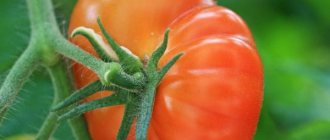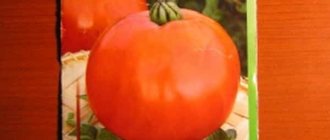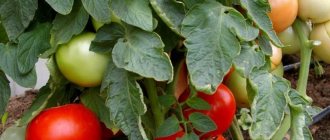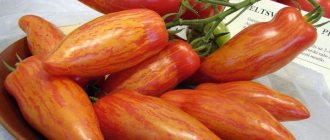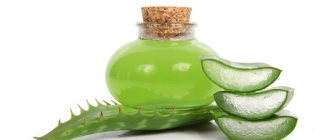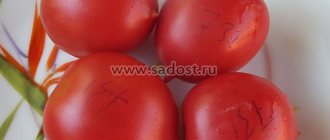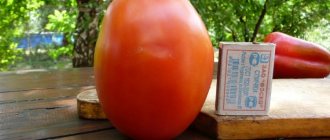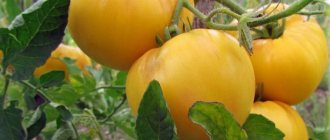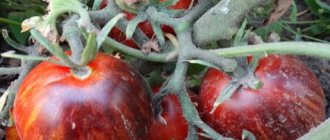Description and characteristics of the variety
- De Barao is a variety of tall tomatoes. They are characterized by a stable yield and good disease resistance.
- The bushes are indeterminate; the stem grows to an unlimited height, so it requires pinching.
- Late ripening. The fruits ripen late: 115-120 days after emergence.
- There are varieties of the variety with fruits of different shapes and colors (red, pink, yellow, black).
- Cultivation is possible not only in a greenhouse, but also in open ground.
- The stem is powerful, with many large pointed leaves of a dark green color.
- The stem can stretch up to 4 meters in height.
- As practice has shown, it is better to form a bush into 1-2 stems, and also to carry out pinching and gartering in a timely manner.
- The variety is resistant to nightshade diseases.
- The inflorescences are simple and compact, the first are formed at the level of 9 or 11 leaves, but everything depends on the variety. After the first inflorescence, all the others begin to form every 3 leaves.
- Approximately 10 brushes are formed on the bush. Up to 7 fruits are formed on each of them. An important feature of the De Barao tomato variety is its consistently high yield, despite changing weather conditions. Moreover, the bushes bear fruit until the first frost.
- Productivity is high. From 1 sq. Mestra can collect up to 40 kg of good quality tomatoes. 1 bush can produce almost 20 kg of tomatoes.
- After harvesting, the fruits can be stored for up to 2 months.
- Tomatoes tolerate long-distance transportation well.
Diseases and pests of De Barao tomatoes
The species is resistant to diseases and pests. However, improper proximity and violation of growing rules can harm the crop and deprive the gardener of the harvest. The main danger to tomatoes is late blight. A fungal infection is manifested by the formation of brown spots on vegetables and herbs. For prevention, use “Barrier” or “Oxychom”.
If the cultivation rules are violated, the De Barao tomato may be attacked by brown rot. The affected specimen cannot be treated. For prevention, the drug “Zaslon” is used.
Tomato plantings can be mowed down by a mole cricket. The insect gnaws at the base of the stem, which leads to disease and complete death of the plant. Vinegar infusion and watering with the preparation “Gnome” can repel the pest. Also, tomato plantings can be attacked by spider mites. The pest manifests itself by the presence of cobwebs and larvae on the back of the leaf. To protect against it, the complex composition “Karbofos” will help.
Tomato de Barao is a high-yielding species with high taste and commercial properties. The fruits can be eaten fresh or for preservation. Following simple cultivation rules will give you a rich harvest of juicy, aromatic tomatoes.
Fruit characteristics
- The shape of the tomatoes is plum-shaped.
- Ripe tomatoes of different subspecies can have the following colors: red, pink, yellow, black.
- The average weight of one tomato is from 90 to 130 g.
- Has 2 seed chambers with a large number of seeds.
- Contains a lot of dry matter.
- Before frost, unripe tomatoes are removed and placed in a dark place. There they ripen and can be stored for a long time.
- The skin is smooth, not too dense.
- The pulp is fleshy, juicy, sweet with a slight sourness.
Advantages and disadvantages
This variety of tomatoes is endowed with a lot of positive properties:
- Easy care.
- Grows well in a semi-shaded area.
- Can withstand slight frosts.
- Stable high yield.
- The variety is resistant to most diseases.
- Once picked from the bush, the fruits can be stored for a long time.
The De Barao variety has almost no disadvantages. The only thing is that during cultivation, powerful bushes require timely removal of stepsons and excess green mass. Also, there are not always positive reviews : not everyone likes the sourness in tomatoes.
Photo
For a more detailed look at the De Barao variety, you can look at the photographs below.
You can also watch a video where an experienced gardener will tell you how best to grow the De Barao variety in a greenhouse.
The tomato variety "De Barao" has several types in its composition. Every gardener will find his own culture to his liking. The fruits of this variety are very tasty and are used to prepare various dishes. Tomatoes are consumed both fresh and canned.
Types - how they differ
Scientists have developed many subspecies of De Barao, which differ somewhat in characteristics and descriptions. They differ according to the following characteristics:
- Fruit shape;
- tomato color;
- taste qualities.
Let's look at the varieties of De Barao tomatoes.
Pink
- After the shoots appear, pink tomatoes ripen in 115 days.
- The finally ripened fruits have a pleasant pink color.
- The yield of this variety of tomatoes is slightly less than others - up to 4 kg.
- The fruits weigh approximately 70 g.
- However, pink tomatoes have thick skins and a pleasant taste.
Advantages:
- Withstands slight frosts.
- Can grow in the shade.
- Good disease resistance.
- Stable harvest.
Red
- Tomatoes ripen 120-130 days after the first shoots appear.
- The main stem reaches up to 2 meters in height.
- The average weight of one fruit is 90 g.
- From one bush you can harvest about 4 kg of tomatoes.
- Plants develop well both in open ground and in a greenhouse.
The advantages of the species include the following qualities:
- develops well even in the shade;
- not exposed to diseases;
- withstands low air temperatures;
- The fruits are beautiful and have an excellent presentation.
The disadvantages include the fact that powerful bushes need to be pinched and excess leaf mass removed.
Red tomatoes are great for canning. If you combine them in one jar with a golden subspecies, the blank will look very beautiful.
Gold
- Golden De Barao has excellent taste.
- The fruits have a golden color.
- Ripens within 115 days.
- By autumn, up to 7 kg of golden fruits (also called yellow) are collected from 1 bush.
- The vegetable contains carotene in large quantities.
Advantages:
- Can develop in partial shade.
- Fruiting is high and stable.
- Not susceptible to disease.
- Tolerates low temperatures.
Flaws:
- Branched bushes are large.
- Excess green matter that should be removed.
Harvest and storage
Tomatoes de Barao are a medium-late ripening variety. The fruits do not always have time to ripen before frost. Therefore, they are collected in an unripe state and kept at home, awaiting ripening. The best storage containers are plastic boxes. The fruits are laid out in 3 layers. Paper is placed between the layers. In this position, tomatoes are well preserved.
Growing de Barao is not suitable for every gardener. This is a variety for creative people, experimenters who can introduce something new into the process of planting and growing such a beautiful variety. However, the rules of agricultural technology come first. Without their use it is impossible to get a good harvest.
Orange
- On average, this tomato fully ripens in 125 days.
- The height of the bush is about 3 meters.
- Very tasty tomatoes have the shape of a plum.
- Each fruit weighs up to 100 g.
- Thanks to the large amount of carotene found in these tomatoes, they have such a beautiful color.
- This species can be grown both in a greenhouse and in open areas.
- Tomatoes are used for making salads and for canning.
- With good care, almost 12 kg of tomatoes can be harvested from 1 bush. Moreover, the bush bears fruit before the onset of frost.
- Tomatoes have positive qualities that are found in all De Barao subspecies.
Black
The characteristics of this variety are practically no different from other De Barao tomatoes. However, these fruits are dark purple in color, almost black.
The weight of one fruit is 50 g.
Harvesting can begin 115 days after sprouts appear.
Striped
- This type of tomato has an oval shape.
- The weight of 1 fruit can reach 70 g.
- The ripe fruit is red with brown stripes.
- Tomatoes have excellent taste and are dense.
- They can be used for winter preparations.
- The striped subspecies is resistant to infection by diseases such as late blight.
Tsarsky
- The plant reaches a height of up to 250 cm.
- Up to 10 clusters are formed on it, on each of which about 7 light red fruits ripen.
- Each tomato weighs up to 130 g.
- This subspecies of De Barao is very fruitful. On average, 15 to 20 kg of tomatoes are harvested from 1 bush per season.
- Royal tomato seeds are difficult to buy, as they are among the rarest varieties of tomatoes.
Advantages:
- High yield and fruit production before the onset of frost.
- Not susceptible to fungal diseases.
- The harvested crop is stored for a long time.
- Used for preparing various dishes, as well as for canning.
- Withstands low air temperatures.
Flaws:
- It is necessary to install a strong support for the bush, which has a large and powerful stem.
- Requires timely removal of excess shoots and leaves.
Giant
- The main stem of this subspecies reaches 2 meters or more.
- The Giant's fruits are shaped like plums. Once ripe, they turn red and weigh about 150 g.
- One bush produces up to 6 kg of tomatoes.
- This tomato variety ripens later than all the subspecies of the De Barao variety.
Features of cultivation
An important feature of these tomatoes is their growth. Some varieties can reach up to 4 meters in length. Therefore, the height of the greenhouse for De Barao tomatoes should be about 3 meters in height.
The seeds are planted at the end of February in special boxes that are installed in the greenhouse. The diving procedure is carried out when 2 strong leaves appear on the seedlings. The sprouts are transferred into cups with a volume of 500 g. 60-70 days after planting the seeds, the seedlings are planted in a greenhouse, and a little later - in open ground.
In the south of Russia, to grow tomatoes in open ground, seeds for seedlings are sown in mid-March. In the regions of the middle zone, seeds begin to be sown at the end of the third ten days of March.
Seedlings are planted in the ground using a checkerboard or linear method according to the scheme - 2 plants per 1 square meter. meter.
More information about growing tomatoes is described in the article: Technology of growing tomatoes. Secrets of planting and care.
You might be interested in: How to properly plant tomatoes in a greenhouse: bush formation diagram, care features, photos and videos
Useful information: How to properly tie tomatoes in open ground: the best methods, step-by-step photo and video instructions
Planting a tomato
Having decided to choose seeds as planting material, you should know about the features of growing strong De Barao seedlings. This must be done in a greenhouse or greenhouse. It is best to use a small box with fertile soil for sowing seeds. Humus is suitable for fertilizer. You can also buy ready-made soil mixture. Planting the seeds itself is simple:
- It is necessary to treat the soil for planting with a weak solution of manganese.
- Plant the seeds at a distance of 1 cm from each other.
- Water the soil with a small amount of water.
- Cover the box with polyethylene and put it on a windowsill or in a greenhouse.
Sprouts should appear within a month and a half. They will be ready for planting in open ground only by the 70th day. Until this point, you should actively water the sprouts. It is also important to remove the film from the box. Plants must get used to their new conditions. It is important that this period coincides with warming. Frosts will destroy weak seedlings, so you should be careful. The planting itself on the land plot is carried out in small holes, 5-7 cm deep. The soil must be fertilized. 4 seedlings fit on one square meter.
It is recommended to cover young plants with film
Experienced gardeners advise covering seedlings with polyethylene if there is a high probability of night frosts. A mini-greenhouse is best. It's not difficult to make. It is enough to install metal arcs at the landing site and attach polyethylene to them. Thus, young plants will be protected from external threats.
